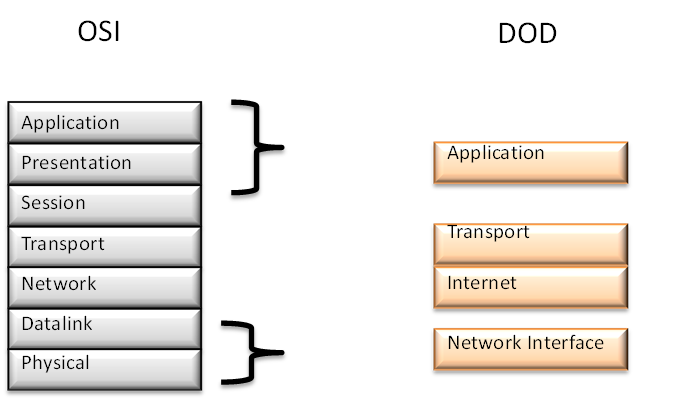It’s time for the next topic for the CCNA.
1.4 Describe the purpose and basic operation of the protocols in the OSI and TCP/IP models
There are tons of books written on the OSI and TCP/IP model so I won’t describe these models in depth here. What I will do is explain what you need to know at each level and explain how the real world works. We have two models, one from OSI and one from DOD.

In the real life everyone references the OSI model. I’ve never heard anyone reference the DOD model which doesn’t mean it doesn’t have its merits but everyone always uses the OSI model as a reference.
The OSI model has seven layers but people sometimes joke that layer 8 is financial and layer 9 is political.
Starting out with the physical layer, what you need to know is auto negotiation. Auto negotiation is good, hard coding speed and duplex will no doubt lead to ports that are hard coded on one side and auto on the other side to end up in half duplex. Gone are the days when auto negotiation wasn’t compatible and lead to misconfigured ports. Very very rarely does auto negotiation fail, until proven otherwise, always use auto negotiation. If you disable auto negotiation, did you know that you also disabled some of the error checking mechanisms of Ethernet such as Remote Fault Indication (RFI)?
At the data link level you should be comfortable with MAC addresses and hexadecimal numbers. Learn how the MAC address is built with the Organizational Unique Identifier (OUI). Often when troubleshooting it is useful to check the OUI of a MAC address to know what is connected to a port. Is it a Cisco device or a PC for example. Learn how easy it is to spoof a MAC. How can you perform an man in the middle attack? How do you protect against that? Learn about port security, Dynamic ARP Inspection, DHCP snooping and so on. Proper layer two security is critical in networks.
At the network layer you MUST know IP addressing. Throw away the subnet calculator and learn how to calculate subnets, usable hosts, subnet ID and the broadcast address manually. This will be the best thing you’ve ever done. If you don’t know subnetting by heart you’ll never become a really skilled network engineer. Everything depends on you knowing IP addressing, calculating wild cards, understanding routing, configuring firewalls and so on.
At the transport layer you must understand the differences between UDP and TCP. Why can UDP utilize the bandwidth fully on my link but not TCP? What is the window size? What are sequence numbers? Why does multicast use UDP? Ask these questions and learn UDP and TCP properly. This will immensly help you in your career down the line. Take the time to really learn TCP/IP and how the windowing mechanism works, what slow start is, why packet loss is really bad for TCP and what the Bandwidth Delay Product (BDP) is. It is also important to understand things such as CEF polarization. How is load sharing performed on Etherchannels? What algorithm can I use to get a better distributed load?
I will group the remaining layers session, presentation and application into one. Learn about different applications such as HTTP, FTP and other applications. You will need to have a good understanding of what ports are used and how the communication is performed. Why does FTP use one port for initial setup and one for transfer? What is passive FTP? The more you understand about applications the better you will be able to help system administrators when they have issues, and they will… Understand how to use Wireshark, why is my TCP performing so badly? What are these duplicate ACKs?
This post should help you understand what to focus on besides learning all the layers and what they do. Good luck in your studies!
I have been reading everything you have posted for a while now and this what you are doing here is unbelievable. Thank you for the time and dedication in everything you post to help everyone out. i will be looking forward for the next part.
Thanks again
Thanks Bob! Wish I had more time as I really enjoy doing this but I’ll do my best to keep them coming at a reasonable pace.
Your article is too good and informative. I am searching for Cisco CCNA and I get the exact article I am thankful to you for sharing this educational article. and the way you wrote is also good, you covered up all the points which I searching for & I am impressed by reading this article. Keep writing and sharing educational articles like this which can help us to grow our knowledge.
CCNA training in Pune